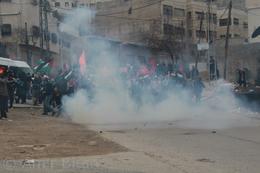During summer 2011, hundreds of thousands of Israelis flooded the streets in the framework of an unprecedented social protest. Under the joint slogan “The people demand social justice!” they raised a long list of issues to the top of Israeli public agenda, issues that have long been left out of any kind of wide public debate: the rising cost of housing, the costs of day to day consumption, the failures of the authorities to respond to citizens’ demands, the continuing erosion of people’s social rights, the state’s abdication of social responsibility, the intimate alliance between the political elite and the very wealthy, the corruption that results from this alliance, and much more.
The mass protests were sparked by students who established a tent encampment to protest the high rent rates for apartments in Tel Aviv’s city center. These students, most of which belong to the traditional middle classes (and in the existing Israeli social reality, this means that the vast majority of them are of Ashkenazi-Jewish descent), succeeded in using their skills and connections in the mainstream media to engender significant public attention., A widespread and diverse protest developed quickly, surpassing any initial plans or predictions.
There is no doubt that photos of these nice young people, sons and daughters of the second or third generation of the well-to-do middle class, suddenly reduced to residing in summer-time tent encampments because of the impossible rent rates, engendered widespread and deep identification at the very heart of the Israeli consensus defined by secular-Ashkenazi cultural elites. The tactical decision of several of the figures crowned “the leaders of the protest” to avoid any statements on political issues beyond the social-economic protest allowed them to gain momentum in the mainstream media that carried their message and to gain widespread support in opinion polls for the first several weeks.
“The salt of the earth” is the most obvious expression of this kind of media and public legitimacy in Israel. This is an expression that authorizes these young people to make demands by virtue of their being the second or third generation of Ashkenazi-Jewish Zionists who served in the army, paid their taxes, and led more or less conformist lives, or in other words, in Zionist jargon, “they contributed their part to the State.” Based on that same Zionist paradigm, their claims do not derive their legitimacy from universal democratic or social rights but rather from the contract supposedly signed between the Jewish-Zionist citizen and his state, a contract in which the former “contributes to the State” and in return the State makes sure to grant them a reasonable head start, to treat them as first class citizen, to grant them the opportunity to get an education and get a good-paying job that will allow him to “make it in life,” to reproduce his parents’ status or eventually to become rich.
Neoliberal economic policy, which has been increasingly implemented in Israel in the last three decades, has eaten away at wealth-redistribution mechanisms and different equal opportunity guarantees until it reached a point that the state, abdicating its social responsibilities, has violated this unwritten contract with “the best of its sons.” It is for this reason that the protest of these middle class young people gained such widespread support at the onset.
It is also true that the Ashkenazi middle classes residing in Israel’s central cities (what some journalists have called the “white Israeli clan”) was the sector that participated most fully in the social protests. And it is no less true to point out that in its messages, its behavior, and its priorities, this sector of social protestors reproduced the same patterns that characterize its day-to-day social position. However, it is important to point out that this sector is extremely heterogeneous in terms of political ideology, and that during the last three decades large portions of this sector have been embroiled in an identity crisis related to its displacement from the top of the political and social pyramid. Its political heterogeneity was expressed in the composition of the group that led the protests in the first few weeks: the group of students that established the first encampment (some of them with various levels of leftist inclination), the Student Union, whose leaders are associated with the Labor Party establishment and its surroundings, the “Dror Israel” socialist-Zionist movement and different activists associated with the Tel Aviv branch of the Israeli Communist Party. The tactical decision to avoid political statements deemed to go beyond the social-economic protest allowed this coalition to survive for a number of weeks without the political tensions between the groups composing it becoming public. This group organized the big mass demonstrations and achieved significant control of the media campaign that represented the struggle.
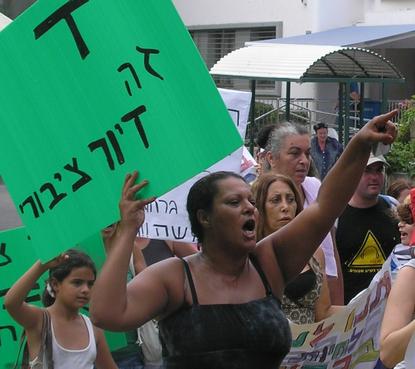
However, this group failed in their attempts to control the many encampments that sprang up and spread throughout the country. Even in the central encampment in Rothschild Avenue in Tel Aviv, an encampment that generally reflected the demands of the young Ashkenazi middle class, the initial organizers lost control to a leadership group that grew out of the democratic, daily assemblies, developing a democratic-participatory approach in an attempt to learn from the general assemblies practiced during the mass protests in Spain. While the Spanish protest provided young Israelis with a radical “Western” model for their rebellion, the democratic uprisings of the “Arab Spring” offered them a surprising challenge. Despite the fear mongering of mainstream pundits and spokespersons of the Zionist establishment concerning the dangers of instability in the region, to some of the Israeli young people, the young people of the Arab world were seen as brave initiators of a brand new mass-movement and even as heroes worthy of emulation. Even the adopted slogan “The people demand social justice!” echoes the slogan that echoed throughout the Arab Middle East—“The people demand the end of the regime!”
This was a popular civil demand of the people in the social and democratic meaning of the word and not just the ethnic-national meaning, which has been perpetuated by Zionism for generations. Despite this echo, however, the “people” in Israel did not demand the end of the regime, and did not dare to think in such revolutionary terms, but rather stayed within the confines of demanding social justice from the regime while recognizing its basic legitimacy.
In different places in Israel, the Student Union and the “Dror Israel” movement tried to control new encampments by providing equipment and by using its agents, but only with partial success. In cities which are heterogeneous in terms of class, separate encampments were established, encampments that reflected the protest of lower social strata, mainly impoverished families with children. These encampments represented housing problems arising from the crises of the public housing system that the Israeli elites neglected and progressively dismantled in the last decades. Thus, side by side with the protests of the middle classes dominated by student organizations, separate popular encampments arose in Jerusalem, HaTikvah neighborhood in Tel Aviv and in Beer Sheva. Encampments focused on the demand for public housing sprang up in a number of working-class cities as well: in Bat Yam, in the Jesse Cohen neighborhood in Holon, in Kiryat Sharet in Holon, the Dora neighborhood young people’s encampment in Netanya, the Kiryat Eliezer encampment in Haifa, the Ethiopian young people’s encampment in Lod and even the joint Jewish-Arab encampment in Jaffa, established by people evicted or threatened with eviction from their apartments, by impoverished people who have been denied public housing or have been listed on waiting lists for years. In some encampments, middle and working class people mixed and worked together: Kiryat Shmonah, Nahariya, Ashdod, Ashkelon, Kfar Saba, Herzliya, Yeruham, Ofakim, Mevasseret Zion, Hedera, and more. This class mixing stood out in most of the Haifa encampments as well as Rishon LeZion and Rehovot.
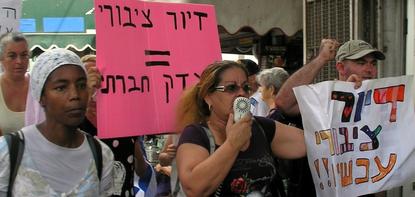
With the expansion of the wave of encampments throughout the country, and especially in the peripheries, the young middle class Ashkenazi leadership had difficulties in communicating with the more popular strata and to make space for them in protest leadership. From the first protest on, the political coalition leading the public protest reduced the representation of Mizrahi and lower class people on the stage to a minimum. Worse, this group tried to dictate what remained of the representation of these groups without consulting with the new leadership emerging from the popular encampments. These habits of controlling and patronizing were also expressed in control over resources donated for the maintenance of the encampments, especially food, which were in dire shortage at certain periods of the popular encampments. But worse than this was the condescension and the unreceptiveness expressed by the middle class leaders in their contacts with people from the popular encampments—an endless number of incidents that expressed the racism, stereotypes and the ignorance of the educated middle classes toward other sectors of society. These incidents pushed the popular leaders to begin to organize by themselves and to search for ways to express their voices in the tumult of the protest, which, given the mainstream media’s eve- present concern with the “middle class” allowed only partial expression of their needs and demands.
The differences in priorities of the different classes in the social protest were most clearly expressed on the housing issue. While the students focused on their own demands, the slightly older groups, educated people in their 20s or 30s, raised the issue of “affordable housing.” This is a demand for government or municipal intervention in the housing market, which will significantly lower rents through special buying conditions (subsided mortgages, free tax projects,etc.) , so that the middle classes can get an apartment of their own without drowning in insufferable mortgages and without having to move to the geographic periphery, distant from their workplaces, or to move to the colonies of the occupied West Bank (the only housing that Israeli governments have continued to subsidize). In the past, and in certain instances in the present, “affordable housing” projects were used as a means of channeling certain preferred populations toward certain areas in order to change or preserve the “demographic balance” within the Green Line (in Wadi 'Ara, for instance). For this reason there are projects to encourage young religious Jewish families to move to the mixed cities in order to gentrify them and to marginalize the original Palestinian population. Similarly, discounted and subsidized housing for students and “strong populations” in impoverished neighborhoods are sometimes used for racist “improvement of the face of the neighborhood” projects, which push out the more impoverished groups, mostly Mizrahi Jews, Ethiopian Jews, or Arabs. This is part and parcel of the internal logic of colonialism deeply embedded in Zionism.
The middle classes, mostly educated and mostly Ashkenazi, demanded that “affordable housing” be accessible to more people at better conditions. The right-wing government was unable to address this demand in a way that won’t harm its own neoliberal principles of free markets and the interests of the big real estate investors, who pull the strings behind senior politicians. This collision between a central social group, which in previous generations was used to enjoying the fruits of Zionist policy, and the capitalist neoliberal economy and neoliberal interests, is a contradiction that has not yet been resolved and which portends more social and political upheavals at the heart of Israeli society.
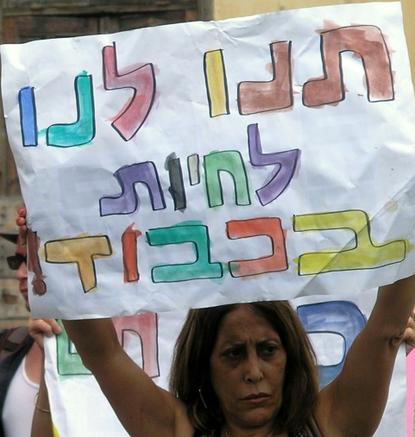
But the demand for “affordable housing” was totally irrelevant to more impoverished groups. Most of the popular encampments were established because, for the last few decades, the state and its housing corporations stopped all construction of public housing, while existing public housing units were increasingly sold at market prices. While the number of impoverished people requiring subsidized housing has greatly increased, the number of available apartments and realistic solutions decreased. The composition of the popular encampments was vastly different than those of the young middle class encampments: many families with young children, mostly of Mizrahi origin, with a significant number of single mothers raising children alone, a large number of people for whom housing is not the only problem, manual laborers with hard life stories, people with disabilities and chronic health problems, sometimes people on parole from prison, and also people who succeeded in recovering from drug-use and alcoholism but are without housing.
The popular encampments were established by working families, but quickly became ad destination for thousands for people that the ever-shrinking welfare services have long since stopped meaningfully serving. The day-to-day routine in the popular tents was the total opposite of the carnivalesque scene that characterized the middle class encampments—continuing struggles for daily needs, tumult, and conflicts among people repeatedly beaten down by the racist and Darwinist Israeli establishment, people scarred by daily struggles of survival, people used to turning their anger at each other. In these encampments there was an endless series of internal struggles, aggression and sometimes even self-harm which only the collective action of the protest could sometimes calm by directing these severe tensions toward the struggle for social change.
Thousands of families and individuals lived in these popular encampments during the summer, though many held out in the tents for only a week or two, retreating to homes of relatives or to other unstable, temporary solutions for the well-being of their children. From a political point of view, these were people who mostly voted for the Likud party or for other right-wing or religious parties, or citizens who hadn’t bothered to vote in the last few elections at all. Through the process of focusing on social rights that were expropriated from them, many of them began to question the existing social and political order. This doesn’t mean that they all changed their political views or had escaped the Zionist pattern of searching for non-Jewish enemies to blame for their troubles. However, it is important to emphasize the total failure of various right-wing provocateurs who tried to channel the outrage of these people against Sudanese or Eritrean refugees or to block cooperation between the Hatikvah encampment in south Tel Aviv and the Jaffa-based Jewish-Arab encampment.
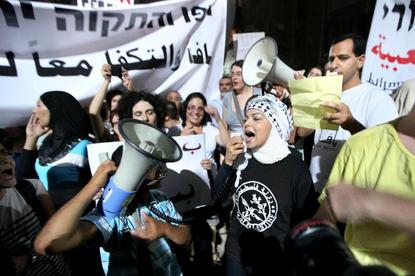
Jaffa and the Tikva protest together
Hithabrut-Tarabut activists together with a small number of other leftist activists chose to focus their efforts on these popular encampments, these encampments that represented the “backyard” of Israeli society. We made a political choice that was the exact opposite of the one made by the Zionist left as well as some non-Zionist leftist partners, like most of the Jewish activists in the Communist Party. From our point of view, real and lasting change in Israeli society can only grow out of these popular struggles, where oppressed populations participate and accumulate experience and awareness, the very same populations that usually serve as fodder for the incitement machine of the racist Israeli right.
Throughout the months of intensive struggle, we saw how a new, popular leadership emerged from below, a leadership which is still local and limited but is growing stronger. We accompanied and supported that same Jewish-Mizrahi leadership, people who began to lead with honesty and steadfastness for themselves and their communities, and who shook themselves of the patronage of corrupt politicians, the vote gatherers and the other middlemen, who in a neoliberal era are no longer able to provide the impoverished populations any protection from the cruelty of wealthy capitalists and market forces. We accompanied and supported them when they dared to cross ethnic-national borders and extend a hand to Arab social activists. We helped public housing activists to meet with leaders of new encampments and passed along information and knowledge that was already accumulated, so that the struggle will be more efficient and focused on the right demands. Under conditions of social isolation and an ideological, institutional hegemony, we tried to help connect the popular social protest to certain traditions of ocial protest in Israel—to the Israeli Black Panthers movement in the 1970's, the Wadi Salib rebellion in the 1950’s, and the tradition of Mizrahi and Arab-Jewish social protest in Israel. We supported the leaders of the popular encampments when they confronted the patronizing attitude of the Ashkenazi left that led the middle class encampments. It can be said that despite the fact that the public image of the protest remained identified with educated, Ashkenazi young people, we succeeded in promoting and pushing forward the demand for public housing, which was barely known at the start of the protest. The success was so great that even today, the media continues to mention this issue and there is a wide and growing consensus concerning this issue in the current public discourse. The struggles against the eviction of people from their public housing apartments are continuing to this day in different cities and neighborhoods, and we are taking an active part in them together with hundreds of activists, most of whom are totally new to social struggle.
The popular encampments are only part of the social protest last summer, and were also a minority compared with the middle class encampments. A great many people in the impoverished Jewish neighborhoods did not join the protest, some because of the influence of right-wing spokespeople who labeled the protest as “leftist.” Others, however, had other reasons for not joining: many, for instance, were fearful about the prospect of joining a protest with people who have no housing. This is perhaps one of the most decisive social question: who will the oppressed choose to support? Will they support those who oppress them but represent a desirable life situation, economic and social security—or will they side with those who are even more impoverished, who represent the menace of a future hopeless reality?
Another key question is the place of Palestinian society in Israel in relation to the social protest. For them, many of the questions raised by the protest were seen as irrelevant. Most Palestinian citizens don’t receive building permits, are discriminated against in municipal planning, and they were definitely not the beneficiary of previous public housing projects except a few examples in the mixed cities. In a protest whose main motto was the struggle for “recovering” rights that had been taken away, it is very difficult to mobilize those who had never enjoyed them to begin with.
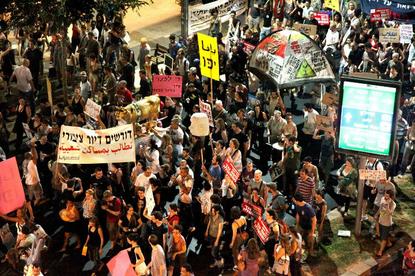
Periphery block demonstration in Tel Aviv, September 2011
Despite this, it is very important to mention that we succeeded, along with other activists, in establishing the “Social Peripheries Bloc”, an alliance between Jewish and Arab community activists, built on the basis of common demands for universal social rights and recognition, communities which are marginal as far as the ruling elites are concerned. The Social Peripheries Bloc continues to meet and organize protests in which hundreds of people participate, mostly people evicted or threatened with eviction, or people whose houses were demolished, both Jewish and Palestinian citizens of Israel. Centered around the demand for housing for all, a connection was created not just between Palestinians from Jaffa and Jews from neighboring impoverished neighborhoods, but also between Bedouin residents of the village of Al Araqib, which was destroyed time after time by the Israeli authorities, and Jews struggling against evictions from public housing units. There were also a number of meetings conducted in frameworks established as the mass protests were winding down such as “the People’s House” (Beit Haam, Beit AlShaab) in Tel Aviv and Hamaabara in Jerusalem, in which representatives of struggles against dispossession like in Kfar Shalem and Dahamash took part, or like the meetings between Palestinian women who live under the constant threat of eviction and demolition and Jewish women who are struggling against being evicted from their homes by the “Amidar” public-housing company, and many more. Embedded in these connections, which are still not taking place on a mass scale but are becoming wider and wider, is the possibility of real political and social change. These connections continue to take place, despite all difficulties and all attempts by the establishment to sabotage them, and despite all the suspicions of people whose thinking was molded by the Zionist strategy of separation to facilitate domination.
It is very possible that the social struggle in Israel will be renewed in the coming spring. If that happens, it is likely that all the complexities and internal contradictions that I have pointed out will be manifested again. It is likely that a large part of the struggle will be run within the confines of the basic Zionist assumptions and that it will reproduce the old Zionist hierarchies based on the cultural superiority of the Ashkenazi middle classes. It is also likely that ideas of exclusive nationalist Jewish unity will be mobilized against the growing polarization and social disintegration created by neoliberalism, and this despite the fact that many others succeeded in expanding the notion of “the people” mentioned in “the people demand social justice” slogan to all citizens of the country and not just the Jewish national collective. But even then, the very fact of democratic protest, the very fact of pushing forward to actualize social rights and the expanding discourse on citizenship and social justice, all these create possibilities and shift political views which had been stuck under the control of the Zionist political right and center throughout the last decade. Every such shift in political views is blessed in the eyes of anybody who is trying to work toward political change in a difficult reality and not just to observe from the sidelines and criticize the goings-on.
On the other hand, we have good reason to assume that this time, the marginalized social strata will have a more meaningful say. Their starting point will be better, after the emergence of leadership among them, after many gained experiences in new connections that criss-crossed the system of classification that neatly divides society in Israel, and their worldviews have become more complex and more critical during the last year. The masses of oppressed and impoverished Mizrahi Jews, hostages of the right-wing and of Shas religious party, are not expected to liberate themselves in one specific moment from political captivity and to become free subjects struggling for themselves and discovering potential allies among those that they had been accustomed to seeing as threats and enemies. But this process might grow from an actual minor phenomenon that happens sporadically to something more meaningful, which has political weight in the balance of power in Israel.
And despite all this, we cannot ignore a very real concern that, in fitting with the age-old Zionist tradition, the protest wave will be channeled to a new wave of colonization, whether by allotting housing solutions through massive construction in the settlements in the occupied West Bank or by building Jewish-only settlement in the Negev as part of the current dispossession of tens of thousands of Bedouins in the unrecognized villages. It’s already happening! In the mixed cities (Lod, Ramle, Jaffa and Acre) we are witness in the last few years to a systematic attempt to offer housing solutions to lower middle class Jewish populations by pushing aside long-time Palestinian residents. It is also reasonable, from a political point of view, just as had been in the past in periods of socio-economic unrest, that leaders like Netanyahu and Barak will try to ignite a war as a means of increasing Jewish public support for the government. It remains to be see whether significant portions of the protest movement will manage to see that the government is trying to distract them through war, as Netanyahu tried to do through a premeditated escalation last summer in Gaza.
The only way to contend with these justified concerns is to join the social protests and to try to influence its content, its direction and its social composition. The boundaries imposed by the Zionist system are clear, and therefore we should not develop exaggerated expectations of these protests. This is not a revolution that will change Israel fundamentally. But the cracks in the Zionist capitalist system are obvious and call us to enter and try to widen them so as to offer the members of our society, Jews and Palestinians, a different future, a democratic future, a future of justice, historical reparation and reconciliation, welfare and dignity.

